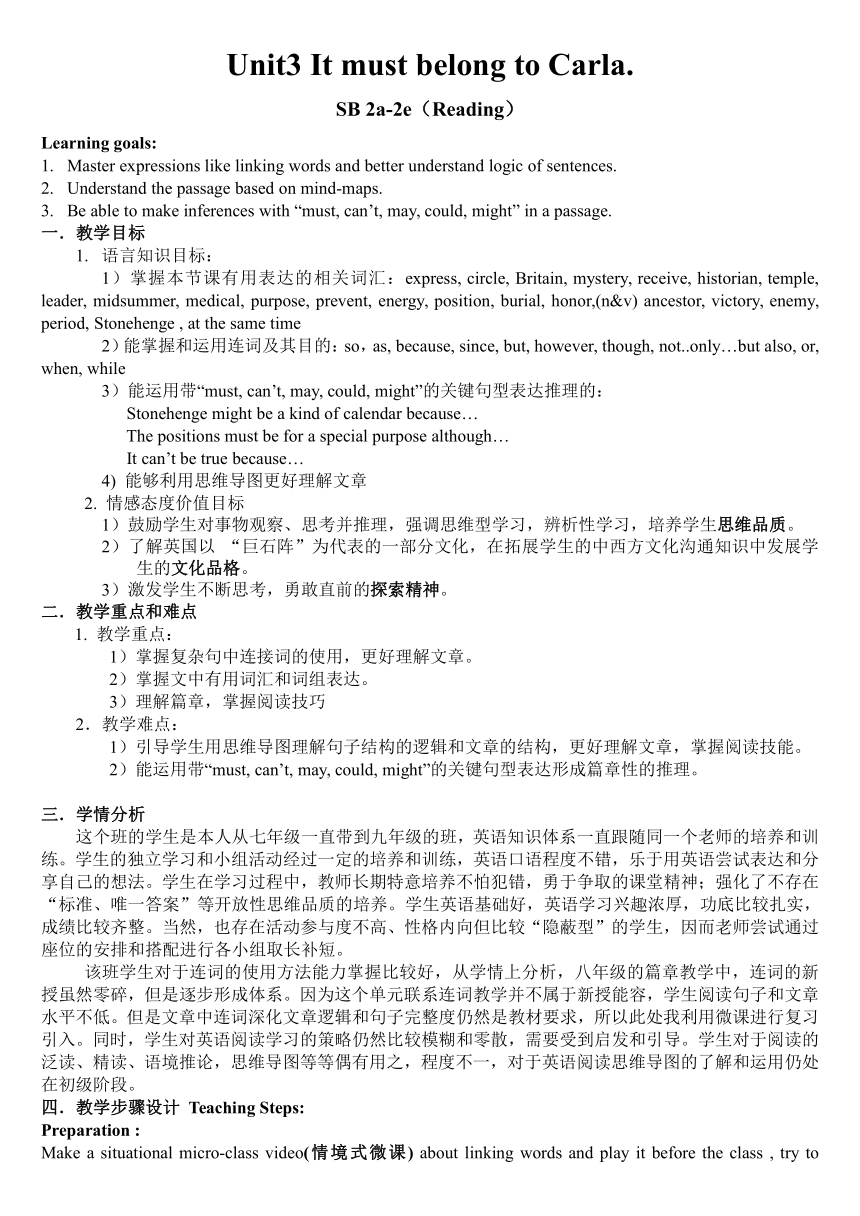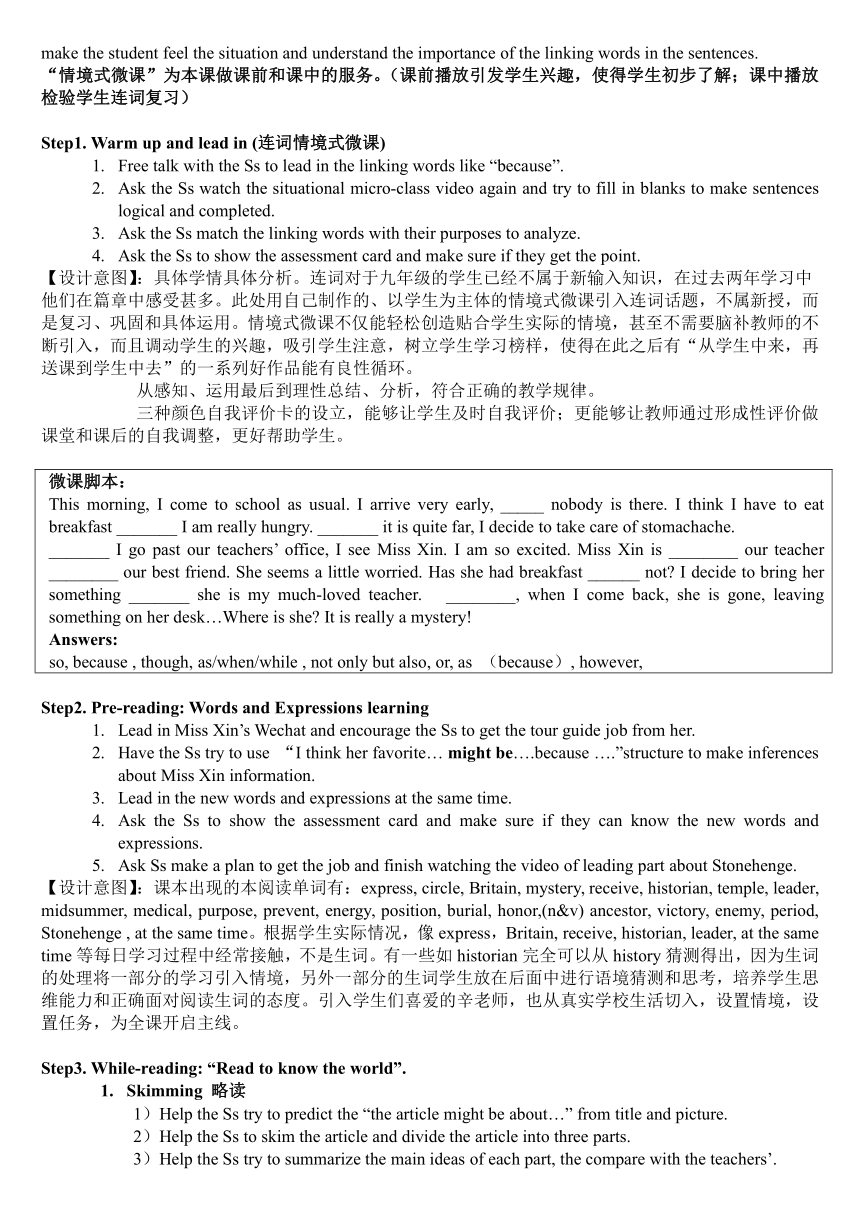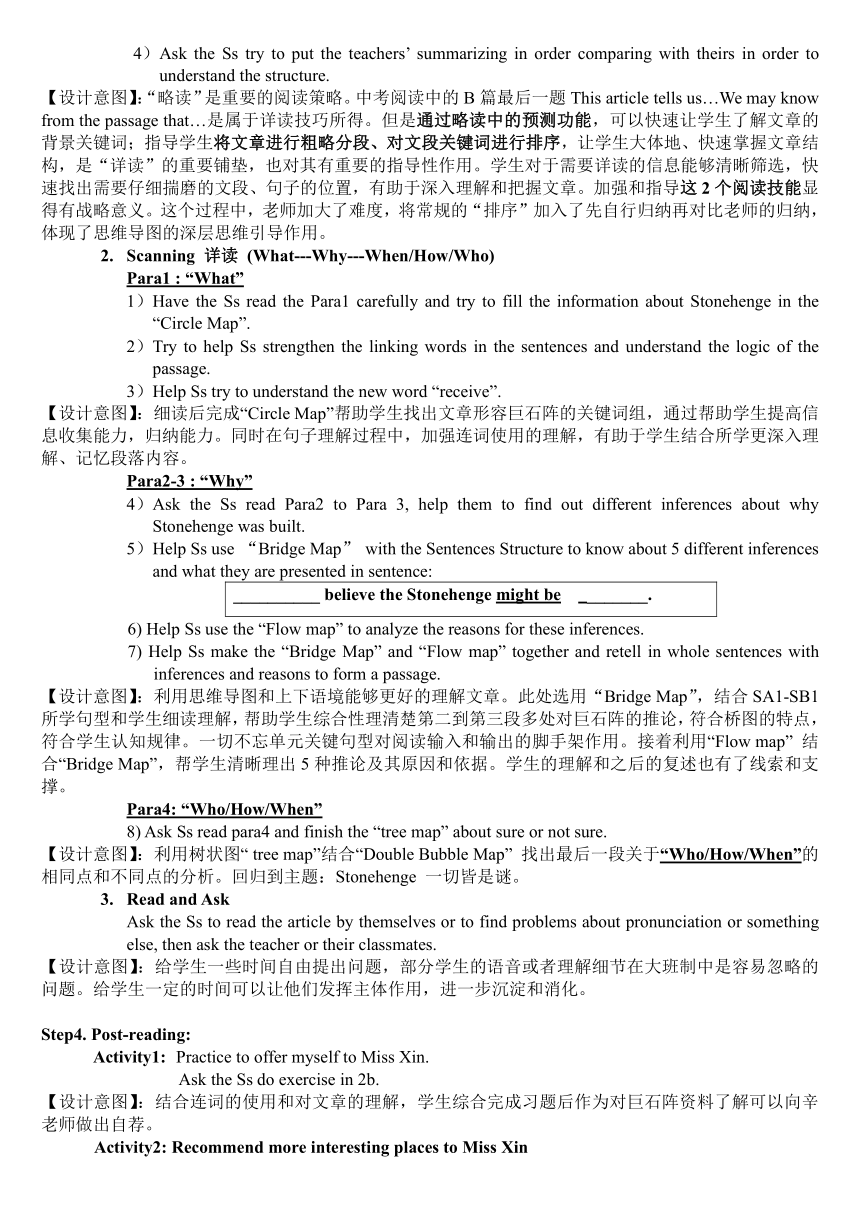鲁教版(五四制)初中英语九年级全册 Unit 3 It must belong to Carla Section B 2a-2e 教案
文档属性
| 名称 | 鲁教版(五四制)初中英语九年级全册 Unit 3 It must belong to Carla Section B 2a-2e 教案 |  | |
| 格式 | docx | ||
| 文件大小 | 327.2KB | ||
| 资源类型 | 教案 | ||
| 版本资源 | 鲁教版 | ||
| 科目 | 英语 | ||
| 更新时间 | 2023-06-01 20:40:13 | ||
图片预览



文档简介
Unit3 It must belong to Carla.
SB 2a-2e(Reading)
Learning goals:
Master expressions like linking words and better understand logic of sentences.
Understand the passage based on mind-maps.
Be able to make inferences with “must, can’t, may, could, might” in a passage.
一.教学目标
语言知识目标:
1)掌握本节课有用表达的相关词汇:express, circle, Britain, mystery, receive, historian, temple, leader, midsummer, medical, purpose, prevent, energy, position, burial, honor,(n&v) ancestor, victory, enemy, period, Stonehenge , at the same time
2)能掌握和运用连词及其目的:so,as, because, since, but, however, though, not..only…but also, or, when, while
3)能运用带“must, can’t, may, could, might”的关键句型表达推理的:
Stonehenge might be a kind of calendar because…
The positions must be for a special purpose although…
It can’t be true because…
4) 能够利用思维导图更好理解文章
2. 情感态度价值目标
1)鼓励学生对事物观察、思考并推理,强调思维型学习,辨析性学习,培养学生思维品质。
2)了解英国以 “巨石阵”为代表的一部分文化,在拓展学生的中西方文化沟通知识中发展学生的文化品格。
3)激发学生不断思考,勇敢直前的探索精神。
二.教学重点和难点
1. 教学重点:
1)掌握复杂句中连接词的使用,更好理解文章。
2)掌握文中有用词汇和词组表达。
3)理解篇章,掌握阅读技巧
2.教学难点:
1)引导学生用思维导图理解句子结构的逻辑和文章的结构,更好理解文章,掌握阅读技能。
2)能运用带“must, can’t, may, could, might”的关键句型表达形成篇章性的推理。
三.学情分析
这个班的学生是本人从七年级一直带到九年级的班,英语知识体系一直跟随同一个老师的培养和训练。学生的独立学习和小组活动经过一定的培养和训练,英语口语程度不错,乐于用英语尝试表达和分享自己的想法。学生在学习过程中,教师长期特意培养不怕犯错,勇于争取的课堂精神;强化了不存在“标准、唯一答案”等开放性思维品质的培养。学生英语基础好,英语学习兴趣浓厚,功底比较扎实,成绩比较齐整。当然,也存在活动参与度不高、性格内向但比较“隐蔽型”的学生,因而老师尝试通过座位的安排和搭配进行各小组取长补短。
该班学生对于连词的使用方法能力掌握比较好,从学情上分析,八年级的篇章教学中,连词的新授虽然零碎,但是逐步形成体系。因为这个单元联系连词教学并不属于新授能容,学生阅读句子和文章水平不低。但是文章中连词深化文章逻辑和句子完整度仍然是教材要求,所以此处我利用微课进行复习引入。同时,学生对英语阅读学习的策略仍然比较模糊和零散,需要受到启发和引导。学生对于阅读的泛读、精读、语境推论,思维导图等等偶有用之,程度不一,对于英语阅读思维导图的了解和运用仍处在初级阶段。
四.教学步骤设计 Teaching Steps:
Preparation :
Make a situational micro-class video(情境式微课) about linking words and play it before the class , try to make the student feel the situation and understand the importance of the linking words in the sentences.
“情境式微课”为本课做课前和课中的服务。(课前播放引发学生兴趣,使得学生初步了解;课中播放检验学生连词复习)
Step1. Warm up and lead in (连词情境式微课)
Free talk with the Ss to lead in the linking words like “because”.
Ask the Ss watch the situational micro-class video again and try to fill in blanks to make sentences logical and completed.
Ask the Ss match the linking words with their purposes to analyze.
Ask the Ss to show the assessment card and make sure if they get the point.
【设计意图】:具体学情具体分析。连词对于九年级的学生已经不属于新输入知识,在过去两年学习中
他们在篇章中感受甚多。此处用自己制作的、以学生为主体的情境式微课引入连词话题,不属新授,而
是复习、巩固和具体运用。情境式微课不仅能轻松创造贴合学生实际的情境,甚至不需要脑补教师的不
断引入,而且调动学生的兴趣,吸引学生注意,树立学生学习榜样,使得在此之后有“从学生中来,再
送课到学生中去”的一系列好作品能有良性循环。
从感知、运用最后到理性总结、分析,符合正确的教学规律。
三种颜色自我评价卡的设立,能够让学生及时自我评价;更能够让教师通过形成性评价做课堂和课后的自我调整,更好帮助学生。
微课脚本: This morning, I come to school as usual. I arrive very early, _____ nobody is there. I think I have to eat breakfast _______ I am really hungry. _______ it is quite far, I decide to take care of stomachache. _______ I go past our teachers’ office, I see Miss Xin. I am so excited. Miss Xin is ________ our teacher ________ our best friend. She seems a little worried. Has she had breakfast ______ not I decide to bring her something _______ she is my much-loved teacher. ________, when I come back, she is gone, leaving something on her desk…Where is she It is really a mystery! Answers: so, because , though, as/when/while , not only but also, or, as (because), however,
Step2. Pre-reading: Words and Expressions learning
Lead in Miss Xin’s Wechat and encourage the Ss to get the tour guide job from her.
Have the Ss try to use “I think her favorite… might be….because ….”structure to make inferences about Miss Xin information.
Lead in the new words and expressions at the same time.
Ask the Ss to show the assessment card and make sure if they can know the new words and expressions.
Ask Ss make a plan to get the job and finish watching the video of leading part about Stonehenge.
【设计意图】:课本出现的本阅读单词有:express, circle, Britain, mystery, receive, historian, temple, leader, midsummer, medical, purpose, prevent, energy, position, burial, honor,(n&v) ancestor, victory, enemy, period, Stonehenge , at the same time。根据学生实际情况,像express,Britain, receive, historian, leader, at the same time等每日学习过程中经常接触,不是生词。有一些如historian完全可以从history猜测得出,因为生词的处理将一部分的学习引入情境,另外一部分的生词学生放在后面中进行语境猜测和思考,培养学生思维能力和正确面对阅读生词的态度。引入学生们喜爱的辛老师,也从真实学校生活切入,设置情境,设置任务,为全课开启主线。
Step3. While-reading: “Read to know the world”.
Skimming 略读
Help the Ss try to predict the “the article might be about…” from title and picture.
Help the Ss to skim the article and divide the article into three parts.
Help the Ss try to summarize the main ideas of each part, the compare with the teachers’.
Ask the Ss try to put the teachers’ summarizing in order comparing with theirs in order to understand the structure.
【设计意图】:“略读”是重要的阅读策略。中考阅读中的B篇最后一题This article tells us…We may know from the passage that…是属于详读技巧所得。但是通过略读中的预测功能,可以快速让学生了解文章的背景关键词;指导学生将文章进行粗略分段、对文段关键词进行排序,让学生大体地、快速掌握文章结构,是“详读”的重要铺垫,也对其有重要的指导性作用。学生对于需要详读的信息能够清晰筛选,快速找出需要仔细揣磨的文段、句子的位置,有助于深入理解和把握文章。加强和指导这2个阅读技能显得有战略意义。这个过程中,老师加大了难度,将常规的“排序”加入了先自行归纳再对比老师的归纳,体现了思维导图的深层思维引导作用。
Scanning 详读 (What---Why---When/How/Who)
Para1 : “What”
Have the Ss read the Para1 carefully and try to fill the information about Stonehenge in the “Circle Map”.
Try to help Ss strengthen the linking words in the sentences and understand the logic of the passage.
Help Ss try to understand the new word “receive”.
【设计意图】:细读后完成“Circle Map”帮助学生找出文章形容巨石阵的关键词组,通过帮助学生提高信息收集能力,归纳能力。同时在句子理解过程中,加强连词使用的理解,有助于学生结合所学更深入理解、记忆段落内容。
Para2-3 : “Why”
Ask the Ss read Para2 to Para 3, help them to find out different inferences about why Stonehenge was built.
Help Ss use “Bridge Map” with the Sentences Structure to know about 5 different inferences and what they are presented in sentence:
__________ believe the Stonehenge might be _______.
6) Help Ss use the “Flow map” to analyze the reasons for these inferences.
7) Help Ss make the “Bridge Map” and “Flow map” together and retell in whole sentences with inferences and reasons to form a passage.
【设计意图】:利用思维导图和上下语境能够更好的理解文章。此处选用“Bridge Map”,结合SA1-SB1所学句型和学生细读理解,帮助学生综合性理清楚第二到第三段多处对巨石阵的推论,符合桥图的特点,符合学生认知规律。一切不忘单元关键句型对阅读输入和输出的脚手架作用。接着利用“Flow map” 结合“Bridge Map”,帮学生清晰理出5种推论及其原因和依据。学生的理解和之后的复述也有了线索和支撑。
Para4: “Who/How/When”
8) Ask Ss read para4 and finish the “tree map” about sure or not sure.
【设计意图】:利用树状图“ tree map”结合“Double Bubble Map” 找出最后一段关于“Who/How/When”的相同点和不同点的分析。回归到主题:Stonehenge 一切皆是谜。
Read and Ask
Ask the Ss to read the article by themselves or to find problems about pronunciation or something else, then ask the teacher or their classmates.
【设计意图】:给学生一些时间自由提出问题,部分学生的语音或者理解细节在大班制中是容易忽略的问题。给学生一定的时间可以让他们发挥主体作用,进一步沉淀和消化。
Step4. Post-reading:
Activity1: Practice to offer myself to Miss Xin.
Ask the Ss do exercise in 2b.
【设计意图】:结合连词的使用和对文章的理解,学生综合完成习题后作为对巨石阵资料了解可以向辛老师做出自荐。
Activity2: Recommend more interesting places to Miss Xin
Have the work in group of 4.
Student A chooses one, makes the mind map and arrange the jobs
Student B writes about Para1,make a report(What).
Student C writes about Para2,make a report (Why)
Student D writes about Para3,make a report (Others we know).
Give the tips of mind map and let the Ss discuss and write down each para.
Have the Ss show together.
【设计意图】:落实到位的理念充分体现,四位同学的责任分明,A同学主导全组,选定地址,安排任务,绘制四位导图,其他几位同学被分配到思维导图中模仿课文体的一些背景介绍,推测和其他经验或知识介绍,连词贯穿在表达之中。从输入到输出,形成一个循环。最后四位同学都要上台,让发挥主导权能够比较平均分配在学生身上,更有参与感。
Step5. Sum up
Read the words and expression on the blackboard.
Introduce more mind maps for the Ss to read and write.
Ss show their Assessment 自我评价.
Encouragement for the Ss.
The exploration探索 of the world should never stop. Keep learning! Keep thinking! Keep learning! It might be “YOU” to tell the world the answers.
【设计意图】:不仅对单词词组进行总结,同时给学生多种思维导图的呈现,启发学生去发现和总结。适时总结评价,学生内心能有自我阶梯的进步规划图,教师也能通过及时的形成性评价对教学做反思和修改。鼓励学生对事物观察、思考并推理,强调思维型学习,辨析性学习,培养学生思维品质。激发学生不断思考,勇敢直前的探索精神。最后一句It might be “YOU” to tell the world the answers.呼应标题。
全课贯彻“课中形成性评价”,三种颜色的卡片互动更有利于老师在大班制的情况下知道学生自我评价和掌握情况,便于记录数据和课后分层加强,各个突破,达到高效率化。本课每个环节只有3-4 学生举红卡。说明情况比较好。
Step6. Homework
1. Send a voice message to Miss Xin , using linking words to tell your story in the morning and try to get the job.运用连词,叙述早上的经历,和辛老师分享。
2. Read an article about another interesting place on the Internet, draw the mind map then try to recommend it to Miss Xin. 不断探求,自画导图,做成自荐信。
【设计意图】:呼应教学目标,落实学生连词使用,使学生在做中学,在学中做。鼓励借用因特网进行知识探索,落实本节课思维导图和主要句型在复述时的呈现。从读到写做课后补充,一一落实到位。
Blackboard Writing
Unit3 It must belong to Carla.
SB 2a-2b (Reading)
Stonehenge, Can Anyone Explain Why It Is There
Linking Words: You mystery
Because
So that…
Since
Sth must be….
Sth might be…
Sth can’t be …..
背景知识: 思维导图
思维导图运用图文并重的技巧,把各级主题的关系用相互隶属与相关的层级图表现出来,把主题关键词与图像、颜色等建立记忆链接。据我收集的资料和参考的课例,大约可以表示为下面几种基础类型。
与各位一起分享,使用时或有个人理解不当,请指正。
1.Circle Map 圆圈图
Circle map 主要用于把一个主题展开来,联想或描述细节。小圈圈是主题,而外面的大圈圈里放的是和这个主题有关的细节或特征。圆圈图是学习事物某一特征最高效的形式。
2.Bubble Map 气泡图
Bubble Map由很多泡泡组成,中间一个主题泡泡描述核心主题,周围的属性泡泡描述关于这个主题的属性。主要是分析、解释和描述事物。
3.Double Bubble Map 双气泡图
Double Bubble Map 是气泡图的“升级版”,主要是比较、对照两个事物,找到它们的差别和共同点。
4.Tree Map 树状图
Tree Map就像一棵树,树根就是主题,枝杈就是这个主题的分类,
而树叶就是这些分类里面的具体内容的描述。
这种类型非常适合学习和测验,比如教单词。
5.Flow Map 流程图
Flow Map描述了一件事情的各个过程。在最大的方框内写事情的主题,小方框写完成事情的步骤。此图从先后顺序的角度去分析事物的发展、内在逻辑。
6.Multi-flow Map 多重流程图
Multi-flow Map也称因果关系图,用来分析一个事件产生的原因,和它导致的结果。当中是事件 Main Event,左边是事件产生的多种原因,右边是事件导致的多个结果。
7.Brace Map 括号图
Brace Map主要是分析整体与局部的关系,理解主题和其属性的联系。它通常用于分析一个事物的结构。
8.Bridge Map 桥型图
Bridge Map用来描述事物之间的相似性和关系,在图的最左边,定义一个主题,右边分别列出各个相似主题的名称和描述。每个描述之间都用as来串联,这就像一座座桥一样,所以这又叫Bridge Map。
个人觉得这个非常难。
9. Fish Bone鱼骨头图,
鱼骨头图分为两种一种是分析原因型,鱼头在右,通常以为什么来写。另一种是对策分析型,鱼头在左,通常以如何做来写。
SB 2a-2e(Reading)
Learning goals:
Master expressions like linking words and better understand logic of sentences.
Understand the passage based on mind-maps.
Be able to make inferences with “must, can’t, may, could, might” in a passage.
一.教学目标
语言知识目标:
1)掌握本节课有用表达的相关词汇:express, circle, Britain, mystery, receive, historian, temple, leader, midsummer, medical, purpose, prevent, energy, position, burial, honor,(n&v) ancestor, victory, enemy, period, Stonehenge , at the same time
2)能掌握和运用连词及其目的:so,as, because, since, but, however, though, not..only…but also, or, when, while
3)能运用带“must, can’t, may, could, might”的关键句型表达推理的:
Stonehenge might be a kind of calendar because…
The positions must be for a special purpose although…
It can’t be true because…
4) 能够利用思维导图更好理解文章
2. 情感态度价值目标
1)鼓励学生对事物观察、思考并推理,强调思维型学习,辨析性学习,培养学生思维品质。
2)了解英国以 “巨石阵”为代表的一部分文化,在拓展学生的中西方文化沟通知识中发展学生的文化品格。
3)激发学生不断思考,勇敢直前的探索精神。
二.教学重点和难点
1. 教学重点:
1)掌握复杂句中连接词的使用,更好理解文章。
2)掌握文中有用词汇和词组表达。
3)理解篇章,掌握阅读技巧
2.教学难点:
1)引导学生用思维导图理解句子结构的逻辑和文章的结构,更好理解文章,掌握阅读技能。
2)能运用带“must, can’t, may, could, might”的关键句型表达形成篇章性的推理。
三.学情分析
这个班的学生是本人从七年级一直带到九年级的班,英语知识体系一直跟随同一个老师的培养和训练。学生的独立学习和小组活动经过一定的培养和训练,英语口语程度不错,乐于用英语尝试表达和分享自己的想法。学生在学习过程中,教师长期特意培养不怕犯错,勇于争取的课堂精神;强化了不存在“标准、唯一答案”等开放性思维品质的培养。学生英语基础好,英语学习兴趣浓厚,功底比较扎实,成绩比较齐整。当然,也存在活动参与度不高、性格内向但比较“隐蔽型”的学生,因而老师尝试通过座位的安排和搭配进行各小组取长补短。
该班学生对于连词的使用方法能力掌握比较好,从学情上分析,八年级的篇章教学中,连词的新授虽然零碎,但是逐步形成体系。因为这个单元联系连词教学并不属于新授能容,学生阅读句子和文章水平不低。但是文章中连词深化文章逻辑和句子完整度仍然是教材要求,所以此处我利用微课进行复习引入。同时,学生对英语阅读学习的策略仍然比较模糊和零散,需要受到启发和引导。学生对于阅读的泛读、精读、语境推论,思维导图等等偶有用之,程度不一,对于英语阅读思维导图的了解和运用仍处在初级阶段。
四.教学步骤设计 Teaching Steps:
Preparation :
Make a situational micro-class video(情境式微课) about linking words and play it before the class , try to make the student feel the situation and understand the importance of the linking words in the sentences.
“情境式微课”为本课做课前和课中的服务。(课前播放引发学生兴趣,使得学生初步了解;课中播放检验学生连词复习)
Step1. Warm up and lead in (连词情境式微课)
Free talk with the Ss to lead in the linking words like “because”.
Ask the Ss watch the situational micro-class video again and try to fill in blanks to make sentences logical and completed.
Ask the Ss match the linking words with their purposes to analyze.
Ask the Ss to show the assessment card and make sure if they get the point.
【设计意图】:具体学情具体分析。连词对于九年级的学生已经不属于新输入知识,在过去两年学习中
他们在篇章中感受甚多。此处用自己制作的、以学生为主体的情境式微课引入连词话题,不属新授,而
是复习、巩固和具体运用。情境式微课不仅能轻松创造贴合学生实际的情境,甚至不需要脑补教师的不
断引入,而且调动学生的兴趣,吸引学生注意,树立学生学习榜样,使得在此之后有“从学生中来,再
送课到学生中去”的一系列好作品能有良性循环。
从感知、运用最后到理性总结、分析,符合正确的教学规律。
三种颜色自我评价卡的设立,能够让学生及时自我评价;更能够让教师通过形成性评价做课堂和课后的自我调整,更好帮助学生。
微课脚本: This morning, I come to school as usual. I arrive very early, _____ nobody is there. I think I have to eat breakfast _______ I am really hungry. _______ it is quite far, I decide to take care of stomachache. _______ I go past our teachers’ office, I see Miss Xin. I am so excited. Miss Xin is ________ our teacher ________ our best friend. She seems a little worried. Has she had breakfast ______ not I decide to bring her something _______ she is my much-loved teacher. ________, when I come back, she is gone, leaving something on her desk…Where is she It is really a mystery! Answers: so, because , though, as/when/while , not only but also, or, as (because), however,
Step2. Pre-reading: Words and Expressions learning
Lead in Miss Xin’s Wechat and encourage the Ss to get the tour guide job from her.
Have the Ss try to use “I think her favorite… might be….because ….”structure to make inferences about Miss Xin information.
Lead in the new words and expressions at the same time.
Ask the Ss to show the assessment card and make sure if they can know the new words and expressions.
Ask Ss make a plan to get the job and finish watching the video of leading part about Stonehenge.
【设计意图】:课本出现的本阅读单词有:express, circle, Britain, mystery, receive, historian, temple, leader, midsummer, medical, purpose, prevent, energy, position, burial, honor,(n&v) ancestor, victory, enemy, period, Stonehenge , at the same time。根据学生实际情况,像express,Britain, receive, historian, leader, at the same time等每日学习过程中经常接触,不是生词。有一些如historian完全可以从history猜测得出,因为生词的处理将一部分的学习引入情境,另外一部分的生词学生放在后面中进行语境猜测和思考,培养学生思维能力和正确面对阅读生词的态度。引入学生们喜爱的辛老师,也从真实学校生活切入,设置情境,设置任务,为全课开启主线。
Step3. While-reading: “Read to know the world”.
Skimming 略读
Help the Ss try to predict the “the article might be about…” from title and picture.
Help the Ss to skim the article and divide the article into three parts.
Help the Ss try to summarize the main ideas of each part, the compare with the teachers’.
Ask the Ss try to put the teachers’ summarizing in order comparing with theirs in order to understand the structure.
【设计意图】:“略读”是重要的阅读策略。中考阅读中的B篇最后一题This article tells us…We may know from the passage that…是属于详读技巧所得。但是通过略读中的预测功能,可以快速让学生了解文章的背景关键词;指导学生将文章进行粗略分段、对文段关键词进行排序,让学生大体地、快速掌握文章结构,是“详读”的重要铺垫,也对其有重要的指导性作用。学生对于需要详读的信息能够清晰筛选,快速找出需要仔细揣磨的文段、句子的位置,有助于深入理解和把握文章。加强和指导这2个阅读技能显得有战略意义。这个过程中,老师加大了难度,将常规的“排序”加入了先自行归纳再对比老师的归纳,体现了思维导图的深层思维引导作用。
Scanning 详读 (What---Why---When/How/Who)
Para1 : “What”
Have the Ss read the Para1 carefully and try to fill the information about Stonehenge in the “Circle Map”.
Try to help Ss strengthen the linking words in the sentences and understand the logic of the passage.
Help Ss try to understand the new word “receive”.
【设计意图】:细读后完成“Circle Map”帮助学生找出文章形容巨石阵的关键词组,通过帮助学生提高信息收集能力,归纳能力。同时在句子理解过程中,加强连词使用的理解,有助于学生结合所学更深入理解、记忆段落内容。
Para2-3 : “Why”
Ask the Ss read Para2 to Para 3, help them to find out different inferences about why Stonehenge was built.
Help Ss use “Bridge Map” with the Sentences Structure to know about 5 different inferences and what they are presented in sentence:
__________ believe the Stonehenge might be _______.
6) Help Ss use the “Flow map” to analyze the reasons for these inferences.
7) Help Ss make the “Bridge Map” and “Flow map” together and retell in whole sentences with inferences and reasons to form a passage.
【设计意图】:利用思维导图和上下语境能够更好的理解文章。此处选用“Bridge Map”,结合SA1-SB1所学句型和学生细读理解,帮助学生综合性理清楚第二到第三段多处对巨石阵的推论,符合桥图的特点,符合学生认知规律。一切不忘单元关键句型对阅读输入和输出的脚手架作用。接着利用“Flow map” 结合“Bridge Map”,帮学生清晰理出5种推论及其原因和依据。学生的理解和之后的复述也有了线索和支撑。
Para4: “Who/How/When”
8) Ask Ss read para4 and finish the “tree map” about sure or not sure.
【设计意图】:利用树状图“ tree map”结合“Double Bubble Map” 找出最后一段关于“Who/How/When”的相同点和不同点的分析。回归到主题:Stonehenge 一切皆是谜。
Read and Ask
Ask the Ss to read the article by themselves or to find problems about pronunciation or something else, then ask the teacher or their classmates.
【设计意图】:给学生一些时间自由提出问题,部分学生的语音或者理解细节在大班制中是容易忽略的问题。给学生一定的时间可以让他们发挥主体作用,进一步沉淀和消化。
Step4. Post-reading:
Activity1: Practice to offer myself to Miss Xin.
Ask the Ss do exercise in 2b.
【设计意图】:结合连词的使用和对文章的理解,学生综合完成习题后作为对巨石阵资料了解可以向辛老师做出自荐。
Activity2: Recommend more interesting places to Miss Xin
Have the work in group of 4.
Student A chooses one, makes the mind map and arrange the jobs
Student B writes about Para1,make a report(What).
Student C writes about Para2,make a report (Why)
Student D writes about Para3,make a report (Others we know).
Give the tips of mind map and let the Ss discuss and write down each para.
Have the Ss show together.
【设计意图】:落实到位的理念充分体现,四位同学的责任分明,A同学主导全组,选定地址,安排任务,绘制四位导图,其他几位同学被分配到思维导图中模仿课文体的一些背景介绍,推测和其他经验或知识介绍,连词贯穿在表达之中。从输入到输出,形成一个循环。最后四位同学都要上台,让发挥主导权能够比较平均分配在学生身上,更有参与感。
Step5. Sum up
Read the words and expression on the blackboard.
Introduce more mind maps for the Ss to read and write.
Ss show their Assessment 自我评价.
Encouragement for the Ss.
The exploration探索 of the world should never stop. Keep learning! Keep thinking! Keep learning! It might be “YOU” to tell the world the answers.
【设计意图】:不仅对单词词组进行总结,同时给学生多种思维导图的呈现,启发学生去发现和总结。适时总结评价,学生内心能有自我阶梯的进步规划图,教师也能通过及时的形成性评价对教学做反思和修改。鼓励学生对事物观察、思考并推理,强调思维型学习,辨析性学习,培养学生思维品质。激发学生不断思考,勇敢直前的探索精神。最后一句It might be “YOU” to tell the world the answers.呼应标题。
全课贯彻“课中形成性评价”,三种颜色的卡片互动更有利于老师在大班制的情况下知道学生自我评价和掌握情况,便于记录数据和课后分层加强,各个突破,达到高效率化。本课每个环节只有3-4 学生举红卡。说明情况比较好。
Step6. Homework
1. Send a voice message to Miss Xin , using linking words to tell your story in the morning and try to get the job.运用连词,叙述早上的经历,和辛老师分享。
2. Read an article about another interesting place on the Internet, draw the mind map then try to recommend it to Miss Xin. 不断探求,自画导图,做成自荐信。
【设计意图】:呼应教学目标,落实学生连词使用,使学生在做中学,在学中做。鼓励借用因特网进行知识探索,落实本节课思维导图和主要句型在复述时的呈现。从读到写做课后补充,一一落实到位。
Blackboard Writing
Unit3 It must belong to Carla.
SB 2a-2b (Reading)
Stonehenge, Can Anyone Explain Why It Is There
Linking Words: You mystery
Because
So that…
Since
Sth must be….
Sth might be…
Sth can’t be …..
背景知识: 思维导图
思维导图运用图文并重的技巧,把各级主题的关系用相互隶属与相关的层级图表现出来,把主题关键词与图像、颜色等建立记忆链接。据我收集的资料和参考的课例,大约可以表示为下面几种基础类型。
与各位一起分享,使用时或有个人理解不当,请指正。
1.Circle Map 圆圈图
Circle map 主要用于把一个主题展开来,联想或描述细节。小圈圈是主题,而外面的大圈圈里放的是和这个主题有关的细节或特征。圆圈图是学习事物某一特征最高效的形式。
2.Bubble Map 气泡图
Bubble Map由很多泡泡组成,中间一个主题泡泡描述核心主题,周围的属性泡泡描述关于这个主题的属性。主要是分析、解释和描述事物。
3.Double Bubble Map 双气泡图
Double Bubble Map 是气泡图的“升级版”,主要是比较、对照两个事物,找到它们的差别和共同点。
4.Tree Map 树状图
Tree Map就像一棵树,树根就是主题,枝杈就是这个主题的分类,
而树叶就是这些分类里面的具体内容的描述。
这种类型非常适合学习和测验,比如教单词。
5.Flow Map 流程图
Flow Map描述了一件事情的各个过程。在最大的方框内写事情的主题,小方框写完成事情的步骤。此图从先后顺序的角度去分析事物的发展、内在逻辑。
6.Multi-flow Map 多重流程图
Multi-flow Map也称因果关系图,用来分析一个事件产生的原因,和它导致的结果。当中是事件 Main Event,左边是事件产生的多种原因,右边是事件导致的多个结果。
7.Brace Map 括号图
Brace Map主要是分析整体与局部的关系,理解主题和其属性的联系。它通常用于分析一个事物的结构。
8.Bridge Map 桥型图
Bridge Map用来描述事物之间的相似性和关系,在图的最左边,定义一个主题,右边分别列出各个相似主题的名称和描述。每个描述之间都用as来串联,这就像一座座桥一样,所以这又叫Bridge Map。
个人觉得这个非常难。
9. Fish Bone鱼骨头图,
鱼骨头图分为两种一种是分析原因型,鱼头在右,通常以为什么来写。另一种是对策分析型,鱼头在左,通常以如何做来写。
同课章节目录
- Unit 1 When was it invented?
- Section A
- Section B
- Unit 2 Teenagers should be allowed to choose their
- Section A
- Section B
- Unit 3 It must belong to Carla.
- Section A
- Section B
- Unit 4 I like music that I can dance to.
- Section A
- Section B
- Unit 5 You’re supposed to shake hands.
- Section A
- Section B
- Unit 6 Sad movies make me cry.
- Section A
- Section B
- Unit 7 Life is full of the unexpected.
- Section A
- Section B
- Unit 8 We're trying to save the earth!
- Section A
- Section B
- Unit 9 It's important to have good habits.
- Section A
- Section B
- Unit 10 I remember meeting all of you in Grade 6.
- Section A
- Section B
